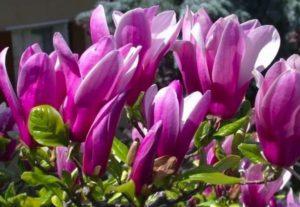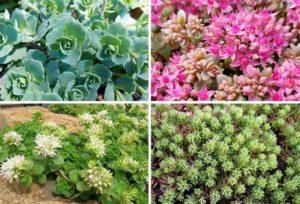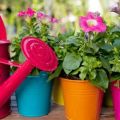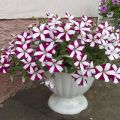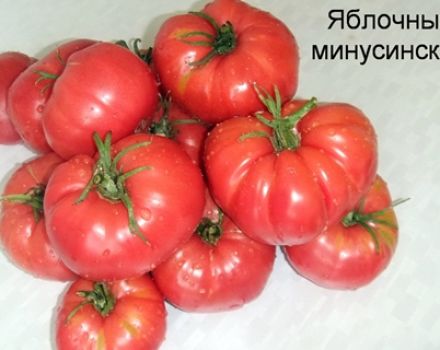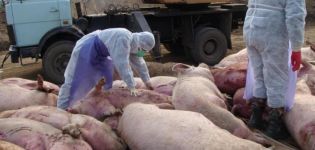How to cut petunia in the fall at home
Petunias are common in Russia. They are grown in summer cottages, balconies, in pots on the windowsills of apartments. One of the most significant questions about growing petunia is the question of its preservation for the winter, for this, methods of transplanting or grafting are used.
Benefits of cuttings growing
Cutting is a method of vegetative propagation of petunias, in which a cutting is separated from the mother bushes and rooted in water or soil. The advantage of this simple method lies in the complete preservation of the properties of an adult plant.
In addition to grafting, petunias are bred with seeds. This method is not very effective due to the impossibility of predicting the landing result in advance. When planting seeds, it is impossible to influence the stages of seedling development.
Some petunias reproduce only vegetatively; these types include numerous terry varieties. These varieties make up a significant part of the petunia collections that are collected by amateur flower growers around the world.
Several parameters are usually called the advantages of grafting:
- preservation of the characteristics of the genotype of the mother plant by cuttings from it;
- short rooting times compared to planting seeds;
- increased endurance of a plant obtained from a cuttings from a mother plant;
- monetary savings on seeds or seedlings.

When is the best time to propagate petunia
Specialists in the cultivation of flower crops consider one of the main advantages of the agrotechnical characteristics of petunias - the ability to carry out cuttings at any time of the year. This allows you to breed a diseased or damaged plant without waiting for the optimal time.
If there is no urgent need to engage in cuttings, then the period from February to May is chosen for it.
Summer cuttings
Breeding petunias in summer has several advantages:
- the presence of natural light by increasing daylight hours;
- optimal temperature conditions.
In summer, plants are obtained from cuttings that are able to bloom indoors in mid-autumn.
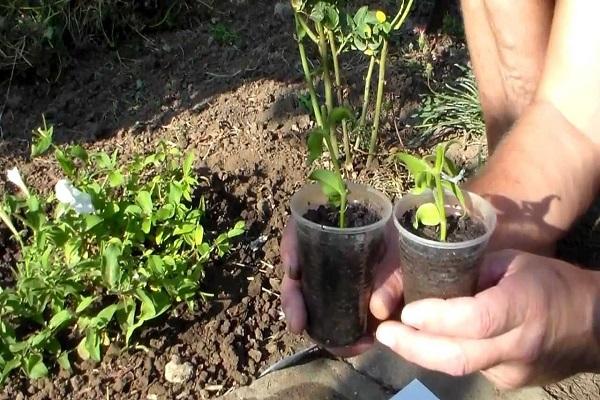
Is it possible to cut petunia in autumn
Autumn pruning of petunias is carried out in order to preserve the plant for the winter and further cultivate the variety at home.
Faded petunias are pruned in September, early October:
- in bush forms, no more than 15 centimeters of the stem are left;
- in ampelous types, approximately half of the stem is cut.
The resulting cuttings are used for further rooting.

Winter cuttings
Winter cuttings begin in advance:
- Petunias are brought into the house for the winter.
- They are pruned: old and damaged leaves are removed. If necessary, prepare for transplantation.
- The mother plant is placed in a spacious planter or pot on the windowsill.
- By February, the mother plant begins to be covered with fresh shoots, they are cut off for rooting.
- The cuttings are placed in water or soil until roots appear.
For grafting petunias, it is taken into account that the period from the cut to planting an independent plant in the ground should be approximately 1.5-2 months.
The result of observing all the rules when breeding petunias is the appearance of roots with the water method of rooting or the ascent of children with the soil method.
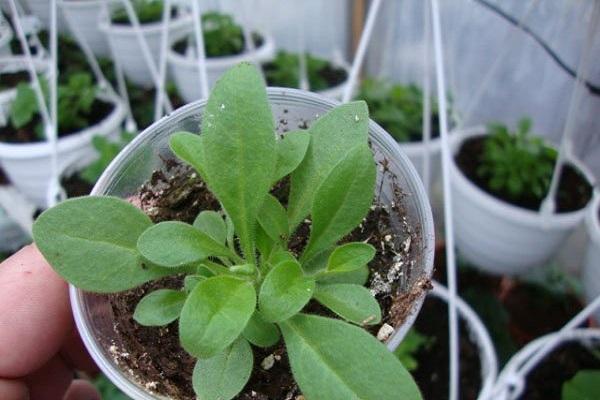
What varieties are suitable for this
Vegetative propagation is suitable for all terry and most hybrid varieties. Special ampelous varieties have been bred by Japanese breeders. They reproduce only by cuttings. This helps to preserve and increase the obtained breeding results.
How to properly propagate petunia by cuttings
Plants grown for seedlings are suitable for cuttings, as well as queen cells from last year's flower beds, transferred to a house for wintering. Cuttings are suitable for rooting in water, soil or peat tablets.
For successful rooting, several rules must be followed:
- compliance with the temperature regime;
- ensuring adequate lighting;
- maintaining air humidity around the cutting.
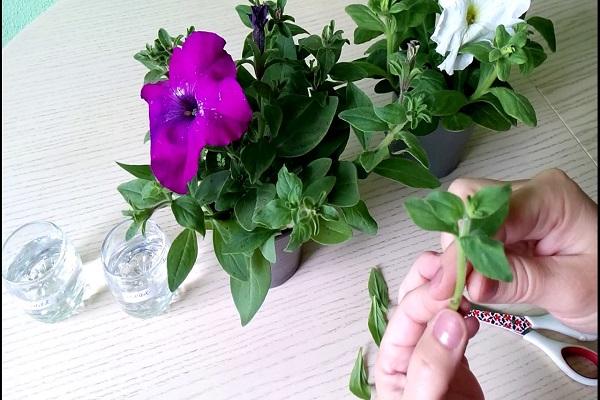
In water
The aquatic breeding method has several advantages:
- rooting can be controlled by observing the stages when choosing a transparent container;
- the possibility of washing the cutting if rot has formed on it, and reusing it.
An activated charcoal tablet is added to avoid infection. The water level should not exceed 2.5 centimeters, this volume is maintained throughout the entire period. Water is added every time it evaporates.
The position of the handle is adjusted using a slotted paper insert or lid.
Advice! If there are several cuttings, then they are covered with a common film or put in a bag.

In the ground
This method involves soil selection. Petunia bud is a source of nutrients. Rooting soil is purchased in specialized stores or prepared at home. At the bottom of the planting container, a drainage layer is placed, which may consist of small river stones or expanded clay. The pot is placed on a special pallet, which will allow watering in a pallet way.
The cut and dried material is planted in moist soil at an acute angle. Planting depth should not be more than 2 centimeters.
The ground around the cutting is tamped, then the container is covered with plastic wrap to ensure the greenhouse effect. Planting is placed away from direct sunlight.
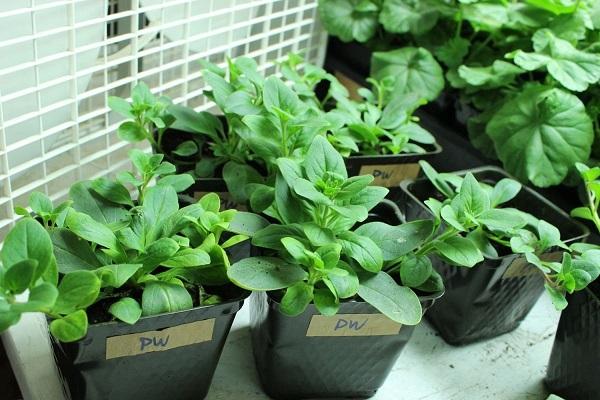
What to do in case of errors
Despite the fact that petunia is considered the most suitable flower for propagation by cuttings, growers often make mistakes that prevent the growth and development of the shoot. The first sign of a problem is that the stalk is not rooting. To understand the reason, it is necessary to assess the general condition of the planting.
| Characteristic | Error symptom | Prevention and elimination measures |
| Temperature regime | The appearance of condensation on the walls of the glass, the accumulation of moisture on the leaves of the appendix | Airing plantings for 10-15 minutes daily, compliance with the optimal regime: it should not exceed +22 ° |
| Air humidity | Condensation build-up or leaf curling. The appearance of spots on the leaves | Regular ventilation, adding water when evaporating |
| The soil | Solid dry soil | Gentle watering, systematic loosening of the soil around the cutting |
| Watering conditions | Dry soil or too moist soil | Watering at the root or regularly replenishing water by evaporation |
| The location of the processes | The shoot lies on the ground, has a stunted, sick appearance | Overflow possible, beginning of root rot |
If the shoot does not take root in the water, rot appears on the cut surface, then the procedure should be repeated. For this, the shoot is taken out, the cut is washed, treated with activated carbon. The water is drained, then a fresh portion is poured with the addition of a manganese solution for disinfection.
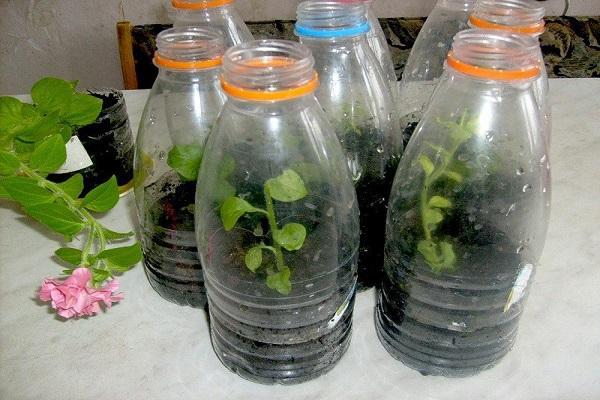
If rotting begins on a cuttings planted in the soil, then such a process cannot be saved. For breeding, a fresh cutting is used with additional processing of the sections and the addition of a growth stimulator.
What to do after the procedure
Hybrid varieties of petunias are especially demanding to maintain optimal rooting conditions. The temperature for germinating cuttings should not be lower than +16.
Information! The first weeks there is an active growth of the root system, so changes in the development of the aboveground part of the plants are invisible.
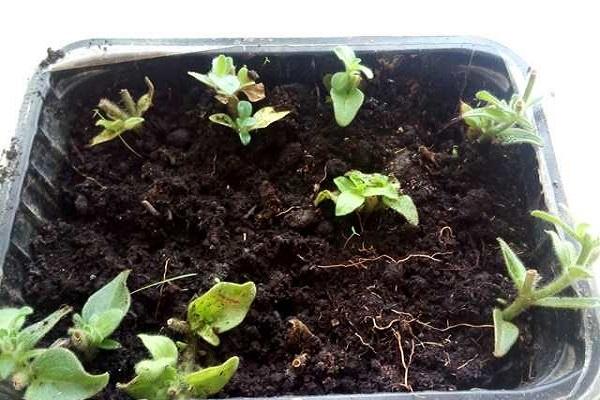
Covering the scions with plastic wrap to create a greenhouse effect becomes unnecessary for 5-7 days.
Daylight hours for petunias should be 11-12 hours, therefore, with a lack of natural light, it is added artificially. For this, photo lamps are used: they are installed at a distance of 20 centimeters from the seedlings.
Morning or evening hours are suitable for watering. The settled water at room temperature is mixed with a few drops of lemon juice.
To grow cuttings, a feeding system is provided, this allows you to make the cuttings procedure more effective:
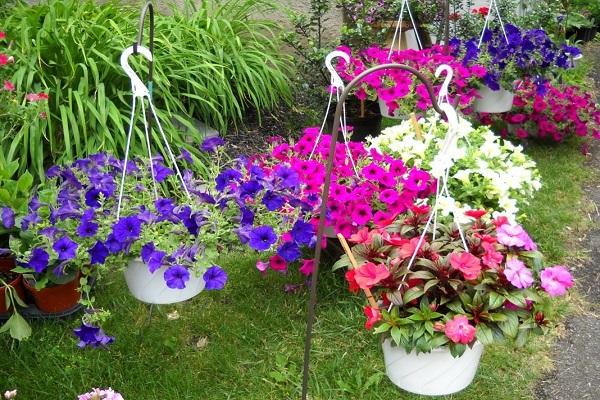
- The first 2 weeks, the shoots are sprayed from a spray bottle with water with the addition of a solution of potassium manganese.
- When leaves appear, fertilizers for the soil begin to be applied to the soil.
- For water rooting, spraying with a growth stimulant is used.
Compliance with the rules and providing conditions for development contributes to the rapid and effective breeding of petunias.
